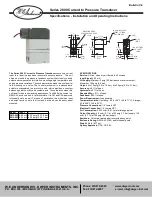
DW1000 User Manual
© Decawave Ltd 2017
Version 2.12
Page 70 of 242
Field
Description of fields within Register file: 0x04 – System Configuration
FFBC
reg:04:00
bit:1
Frame Filtering Behave as a Coordinator. FFEN must be set to enable this frame filtering
operation. A coordinator will accept a frame without a destination address if the source
address has the PAN_ID matching the coordinator’s PAN_ID. For an ordinary (non-
coordinator) node the destination address (if present) must match the node’s own address
or the frame will not be accepted. When FFBC is set to 1 the DW1000 will behave as a
coordinator. When FFBC is clear the DW1000 will behave as an ordinary normal node.
Section 5.2 describes frame filtering in more detail.
FFAB
reg:04:00
bit:2
Frame Filtering Allow Beacon frame reception. IEEE 802.15.4-2011 frames begin with three
bits, indicating the frame type for beacon frames these are binary 000. When FFAB is set to
1 beacon frames will be accepted (assuming all other frame filtering rules are passed) and
when FFAB is clear beacon frames will be ignored. Section 5.2 describes frame filtering in
detail.
FFAD
reg:04:00
bit:3
Frame Filtering Allow Data frame reception. IEEE 802.15.4-2011 frames begin with three
bits, indicating the frame type, b3 to b0, for data frames these are binary 001. When FFAD is
set to 1 data frames will be accepted (assuming all other frame filtering rules are passed)
and when FFAD is clear data frames will be ignored. Section 5.2 describes frame filtering in
more detail.
FFAA
reg:04:00
bit:4
Frame Filtering Allow Acknowledgment frame reception. IEEE 802.15.4-2011 frames begin
with three frame type bits, b3 to b0, for acknowledgment frames these are binary 010.
When FFAA is set to 1 acknowledgment frames will be accepted (assuming all other frame
filtering rules are passed) and when FFAA is clear acknowledgment frames will be ignored.
Section 5.2 describes frame filtering in more detail.
FFAM
reg:04:00
bit:5
Frame Filtering Allow MAC command frame reception. IEEE 802.15.4-2011 frames begin
with three frame type bits, b3 to b0, for MAC command frames these are binary 011. When
FFAM is set to 1 MAC command frames will be accepted (assuming all other frame filtering
rules are passed) and when FFAM is clear MAC command frames will be ignored. Section
5.2 describes frame filtering in more detail.
FFAR
reg:04:00
bit:6
Frame Filtering Allow Reserved frame types. IEEE 802.15.4-2011 frames begin with three
frame type bits, b3 to b0. The values of binary 100 through 111 (4 to 7) are not defined in
IEEE 802.15.4-2011 and would normally be rejected. When FFAR is 0 these frames may be
ignored (depending also on FFA4 and FFA5 which modify this behaviour). When FFAR is set
to 1 these frames are accepted. Since these frame types are unknown no further frame
decoding is done (e.g. no address matching etc.) and the software will thus be responsible
for validating and interpreting these frames. Section 5.2 describes frame filtering in more
detail.
Note that the frame filter does decode the frame control fields to determine the minimum
length of the expected frame and will reject the frame if it is too short, see section 5.2.
FFA4
reg:04:00
bit:7
Frame Filtering Allow frames with frame type field of 4, (binary 100). IEEE 802.15.4-2011
frames begin with three frame type bits, b3 to b0. The value of binary 100 is not defined in
IEEE 802.15.4-2011. When FFA4 is set to 1, frames of type 4 will be accepted, but no
further frame decoding is done (e.g. no address matching etc.) so software will be
responsible for validating and interpreting these frames. When FFA4 is set to 0, frames of
type 4 will be ignored unless FFAR is set. Section 5.2 describes frame filtering in more
detail.
Note that the frame filter does decode the frame control fields to determine the minimum
length of the expected frame and will reject the frame if it is too short, see section 5.2.
















































